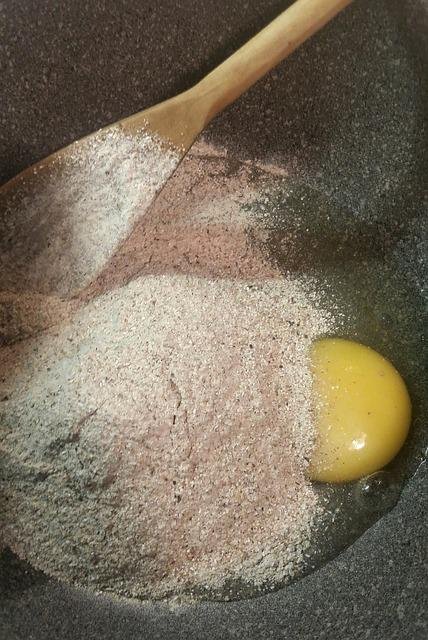
Buckwheat flour is rich in minerals, suitable for celiacs and recommended in the case of diabetes. Discover its benefits and how to use it in the kitchen.
Buckwheat flour is a food that has only recently been rediscovered, but has been widespread throughout Europe for several millennia. In our peninsula it is grown mainly in the northern regions, where it is also used in the preparation of traditional dishes, such as the famous pizzoccheri.
Buckwheat, despite what the name may make us think, is not a “relative” of wheat and not even a cereal, but a pseudocereal, containing more proteins and minerals than the wheat itself.
Buckwheat and consequently buckwheat flour has returned to spread in recent years both thanks to the spread of greater attention to healthier and more natural diets, and thanks to the fact that it is gluten-free and can therefore represent the basis of nutrition for all those suffering from celiac disease or gluten-related conditions.
Buckwheat flour appears beige in color, much more similar to the color of wholemeal flour, rather than the more well-known 0 flour. As we will see later in the article, this flour is difficult to use for baking precisely because it does not contain gluten and therefore is often mixed with wheat flour. For those who can consume gluten, the addition of buckwheat to the normal dough gives a more aromatic and full flavor to the dish, as well as adding different nutritional properties.
Buckwheat flour: calories and nutritional values
The properties of buckwheat flour are almost the same as the properties of buckwheat.
As we have already anticipated, it is a flour rich in some minerals such as iron, phosphorus, potassium and zinc. From the point of view of calories, 100 grams of flour provide about 350 kcal, a value similar to that of other types of flour. Furthermore, it is a product rich in complex carbohydrates (starch) with a medium-low glycemic index (equal to 40) and a fair amount of protein.
If compared to other more commonly used flours it has a composition expressed in macronutrients (carbohydrates, proteins and fats) quite similar, although it is richer in starch than both flour 0 and whole wheat flour. Buckwheat flour, however, has the advantage of being much richer in minerals, especially when compared to flour 0: for example, it contains double the iron, four times more zinc, and almost double the potassium. The table below shows the nutritional values of buckwheat flour.
Nutritional values per 100g of buckwheat flour:
- Power: 350 kcal
- Waterfall: 13.2 g
- Carbohydrates: 84.9 g
- Fibers: 2.1 g
- Fat: 1.5 g
- Proteins: 8.1 g
- Iron: 2 mg
- Folate: 54 μg
- Potassium: 220 mg
- Phosphorus: 150 mg
- Zinc: 2.6 mg
- Vitamin B1: 0.28 mg
- Vitamin B3: 2.8 mg
- Vitamin B6: 0.4 mg
Buckwheat flour: the health benefits
The benefits of buckwheat flour are manifold, due both to the presence of the previously mentioned micronutrients, and to the presence of other substances, called polyphenols, among which the best known and most studied is rutin.
An analysis of the literature in particular has shown that the increase in consumption of this food is linked to a reduction in the levels of total cholesterol and triglycerides, cardiovascular risk parameters. This analysis, however, concludes that no statistically significant improvement in other cardiovascular risk parameters (weight, blood pressure, LDL cholesterol) related to increased buckwheat consumption has been reported.
Its consumption is also associated with a reduction in blood glucose levels.
Furthermore, rutin has shown antioxidant properties or has been shown to eliminate free radicals. Rutin is not the only substance with antioxidant activity present in buckwheat: a great role is also played by quercetin, which also has anti-inflammatory and antiviral properties.
What does buckwheat flour taste like?
The taste of buckwheat flour is more aromatic than common wheat flour: the polyphenols present give this food a slightly bitter aftertaste, an aspect that is reported by most people who taste it for the first time. Another frequently reported aftertaste is that of hazelnut: in short, an intense bouquet of flavors to be discovered!
How buckwheat flour is used
Now let’s see how to use buckwheat flour in the kitchen: this is not a child’s play because from a technological point of view it is one of the most complex flours to work.
First of all, buckwheat flour does not rise: it does not absorb gas and is not fermented by yeasts. For this reason, in the recipes of bread or pizza or focaccia we advise you not to use this flour alone, but mix it with flours richer in gluten, such as wheat. This trick is obviously unusable in case of celiac disease: in this case it is possible to mix it with special flours or use gums, such as xanthan.
Where you do not have to prepare leavened products, buckwheat flour can be substituted for other flours, without having to resort to special precautions. Just remember that it absorbs a greater quantity of liquids and therefore the product will be more crumbly and crunchy, compared to the same food prepared with wheat flour. A good solution could be to insert it in a percentage of 20-30% of the total flour required in the recipe.
This food is more suitable for the preparation of savory dishes : we recall in this regard the aforementioned pizzoccheri, a tasty first course prepared with buckwheat flour. However, we can also use it in the preparation of desserts: for example, it is possible to prepare completely gluten-free biscuits with only buckwheat flour or by mixing it with rice flour.
How to make buckwheat flour at home?
Preparing homemade buckwheat flour is very simple: it is enough, in fact, to get buckwheat and a powerful mixer. First you will have to briefly toast the buckwheat in a pan, which comes in grains, about the size of a grain of corn. Then we can pass it in the mixer and operate it until we have a fine powder. If we opt for whole buckwheat, it should be borne in mind that it has a higher fiber content and it may be necessary to chop it for a longer time than the hulled version.
How to store buckwheat flour?
Buckwheat flour, like other flours, does not have an expiration date, but a minimum shelf life, after which the nutritional properties seen above may no longer be maintained. The advice we provide you for the conservation of this food can therefore be applied to the conservation of all flours: first of all, once opened, we suggest you move the contents into an airtight container, which will allow you to increase the storage time. Furthermore, this container must be kept in a cool place, away from bright lights and heat sources.
Does buckwheat flour contain gluten?
Buckwheat flour is naturally gluten-free and therefore suitable for anyone suffering from celiac disease and gluten-related disorders. Even the products deriving from buckwheat are gluten-free, however we remind those suffering from celiac disease that the problem of contamination persists and that the products allowed are only those declared gluten-free.
Can anyone with diabetes use buckwheat flour?
Diabetes sufferers are often told to pay attention to sugars and, less frequently, to pay attention to foods with a high glycemic index. Buckwheat is a food rich in carbohydrates with a low glycemic index, therefore comparable to wholemeal products, recommended for anyone suffering from diabetes.
The general advice, however, might be to always combine your chosen carbohydrate source with a generous portion of vegetables and a source of protein. Implementing this scheme will lower the glycemic load of the meal, making it even more useful in case of diabetes.
As for the quantities, given that each of us has different characteristics and therefore different needs, we suggest you follow the rules of the “healthy dish” which consists of dividing your plate into 4 quarters: occupy two of them with vegetables and fruit, one with a source of protein of your choice and the last quarter with a source of carbohydrates, in this case buckwheat or products made with the flour of this pseudocereal.
Does buckwheat flour contain nickel?
Buckwheat, as well as its flour, is one of the cereals with the highest nickel content, along with millet, wholemeal products and oats. For this reason its use is not recommended where your reference professional has suggested a nickel-free diet. This diet will generally have to be followed for a limited period of time, at the end of which the excluded foods can be reintegrated, subject to monitoring.
Contraindications of buckwheat flour
There are no particular contraindications to the consumption of buckwheat flour, with the exception of nickel allergy, especially when it presents itself with gastro-intestinal symptoms.
It is also important to underline that, albeit in rare cases, it is possible to develop an allergy towards buckwheat : in this case this flour must be absolutely avoided. Finally, we remind you that some components of buckwheat have anti-haemorrhagic properties and therefore its consumption could interfere with some drugs : if you are taking anticoagulant therapies, we advise you to ask your doctor for advice and possibly limit or exclude buckwheat flour from yours diet.
Does buckwheat flour make you fat?Does your belly swell?
No single food makes you fat, much less buckwheat flour! Remember that we are talking about a food rich in carbohydrates and starches: it is therefore its excess consumption that could lead us to gain weight or prevent us from losing weight. However, if consumed in the right proportions, this flour can give us a lot of satisfaction and reward us with many beneficial properties.
This food also contains a good amount of fiber that can help intestinal regularity : in case of constipation and bloating associated with this condition, the introduction of buckwheat flour could help us.
According to studies, buckwheat flour is also devoid of fermentable sugars and can therefore be integrated even in the case of swelling related to irritable bowel syndrome.
The only case in which buckwheat flour could be associated with the symptom of a swollen belly is in case of nickel allergy: we therefore reiterate, in this case, to follow the instructions of the reference specialist.
Buckwheat flour: prices and where to buy it
If you want to buy buckwheat flour, do not worry because it is extremely widespread and it is easy to find it in almost all supermarkets, in the department dedicated to flour and bakery products. Where, however, your trusted supermarket does not have one, you can also find it online and in particular also on the websites of various mills. The price of this flour is around 6-7 euros per kg, but by looking well and buying it in higher quantities it is certainly possible to save money.






